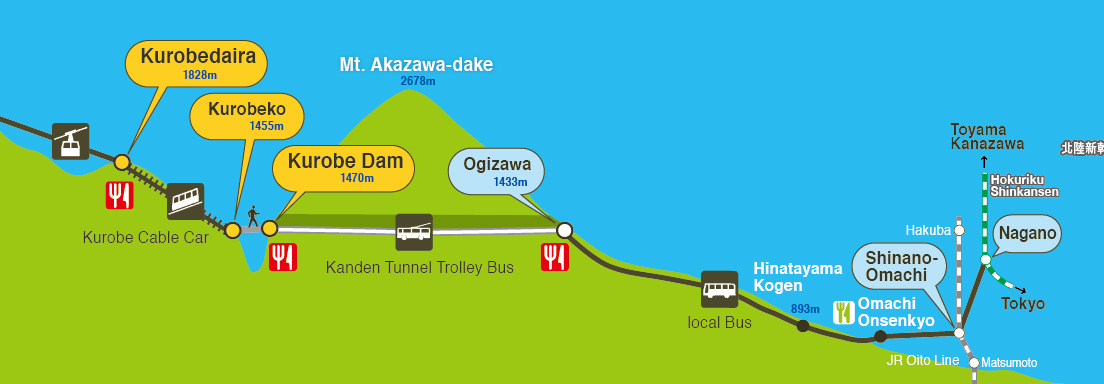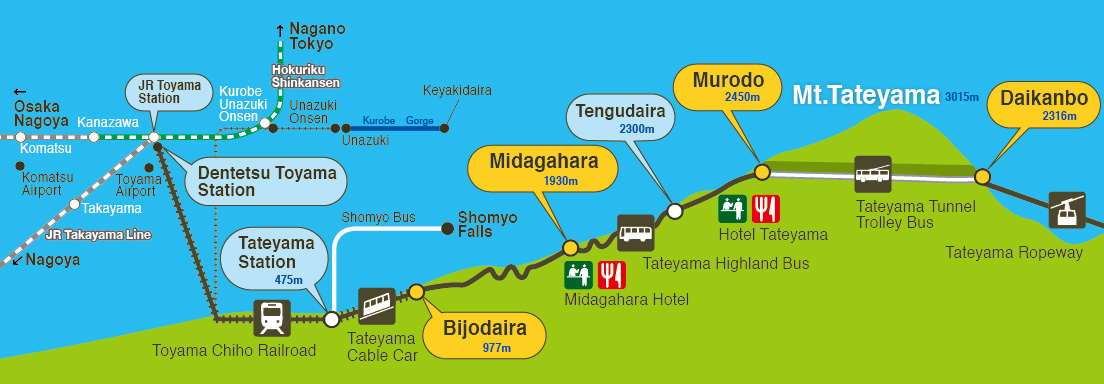28 May 2016
The plan for the day was to travel the Tateyama Kurobe Alpine Route from Ogizawa to Toyama and then travel by Shinkansen to Kanazawa. The Alpine route would take about 6 hours and hence an early start from Matsumoto was needed. The train from Matsumoto to Shinano Omachi is not frequent and it was important that we got on the 7.15 AM train on the JR Oito Line to Shinano Omachi, and then catch the 8.30 AM or 9.00 AM bus to Ogizawa.
The train to Shinano Omachi was a local train and made stops at every station. The scenic views of the alps and rice fields kept us occupied and the hour long journey passed by quickly.
We managed to catch the 8.30 AM bus from Shinano Omachi station to Ogizawa. At the Ogizawa station, we bought the one-way combination ticket for the entire journey to Toyama. We also bought some steamed pork buns to consume while queuing for the Kanden Tunnel Trolley Bus to Kurobe Dam. The Kanden Tunnel Trolley Bus was a convoy of electric powered buses that took the long lines of visitors through a tunnel under Mount Akazawa-dake and to the dam in batches. This tunnel was specially built to bring material to construct the Kurobe Dam.


Overview of the transportation along the Tateyama Alpine Route from Shinano Omachi to Kurobeidaira – as shown in the visitor’s official website.
At the Kurobe Dam, we walked up a flight of 200 steps to the lookout point. Amazing scenery of the Kurobe Dam against the backdrop of the Japanese Alps. At 1,454m above sea level, Kurobe Dam is the highest arch dam in Japan.

There is a second lookout point at the lower part where it is supposed to give good views of the water discharge from the dam. The water discharge only takes place from June onwards when the water level in the dam is higher.
The air was slightly more chilly at this higher altitude of 1454m above sea level. A hot cup of coffee from the vending machine was perfect to warm the body before the 15 minutes walk across the dam. The Kurobeko Station is located at the far end of the dam.
From the Kurobeko Station, we queued again for the 5 minutes cable car ride to ascend to Kurobedaira. From there, we immediately took the 7 minutes ride on the ropeway to Daikanbo.

Daikanbo offered excellent panoramic views of the Japanese Alps from the roof of the station. Worth walking up to take a look but we did not stay too long there as our plan was to spend more time at Murodo.


Overview of the transportation along the Tateyama Alpine Route from Daikanbo to Toyama– as shown in the visitor’s official website.
A 10 minutes ride on the Tateyama Tunnel Trolley Bus brought us to Murodo Station, on the other side of the Tateyama mountain.
Murodo station was packed as it was the midpoint and convergence point for visitors doing the route from West to East and also from East to West. Murodo is also the venue of the famous snow wall that we came to experience.
Before anything else, we went to deposit our backpacks in a locker before settling down for lunch at a large restaurant inside the station.

Belly filled, we went out into the cold environment to experience the snow wall, a short walk away from the Murodo Station.
At 2,500m, Murodo is the highest point on the Tateyama Kurobe Alpine Route and experiences one of the heaviest snow falls in Japan. An average of 7 meters accumulates every year. In those years with heavier snowfall, up to 20 meters can accumulate! Special snow ploughs, GPS guided, that can remove 4000 tons of snow per hour were used in April to clear a path for the buses.
The snow walls, in end May, were not as impressive as what we saw in the brochures.



From the snow wall, we went on a walk on the Mikurigaike trail. One of the highlights of this trail is the crater lake of Tateyama Volcano. From June, when the ice on the lake melts, we should be able to see the peak of Mt. Tateyama reflected in the cobalt blue surface of the pond. Unfortunately, the ice was only half melted.
This pond was called “a kitchen pond for god” and its water was used to cook meals for the god residing on the mountain. This area is home to many rare alpine plants and rare “Raicho” ptarmigan birds.

Further on, we could see and smell sulphuric plumes from the volcanic Jigokudani.




We spent about 3 hours at Murodo before taking the Tateyama Highland bus down to Bijodaira.
From there, we were all squeezed into the cable car for the 7 minutes journey down to Tateyama Station. There were only 2 cabins in the cable car and we experienced the “Tokyo subway peak hour” crush. Thankfully, we were the first few to board the cable car and managed to get seated with our backpacks on our laps.
After surviving our descend into Tateyama, we took the slow Toyama Chiho Railway train to the Dentetsu Toyama station. The journey took about an hour and the train running on the old tracks made a nice rhythmic sounds like Bee Gees’s Jive Talking and I could have easily fallen asleep listening to it.
Toyama seems to be a big city and the station is quite modern. We had to go to the JR Toyama Station to catch the Hokuriku Shinkansen bullet train to Kanazawa. This train service was only one year old and it was my first Shinkansen ride.
Pretty impressive. The train was spacious, offered plenty of leg room and surprisingly quiet! It was only one stop, took 20 minutes and 2810 Yen for an unreserved seat and was an excellent way to get to Kanazawa. A normal train ride would have taken much longer.
Kanazawa Station is pretty impressive and modern. Hotel Nikko Kanazawa, where we stayed for 2 nights, is located just across the station and connected to the station via the underground passage. The hotel is one of the tallest building in the city and we were lucky to have a room on a high floor with wonderful views. We managed to catch a view of the golden sun setting into the sea of the Japan from the room.
Shortly after sunset, the city lights came on and the view of Kanazawa from the hotel was awesome.

There are lots of eating places around and within the Kanazawa Station. Kanazawa is located near the sea and famous for the quality seafood. We went to Maimon sushi restaurant and tasted one of the freshest and value for money sushi meal in Japan.
We sat at the counter and watched the skilful chef prepared our sushi.


The set meal came with a bowl of miso soup cooked with dish bone in it and what looked like an eel.

Not satisfied with just sushi for dinner, we went to Samurai Ramen to share a bowl of hot ramen.

Having delicious Japanese food was the perfect end to a great day of sightseeing and experiencing lots of things in Central Japan.
Travel tip:
We did luggage forwarding using Luggage Forwarding Service or Takuhaibin. It is a convenient service for sending luggage and various other types of goods from door to door nationwide in Japan. Delivery is usually on the next day, and costs are moderate. We made use of this service to make our travels much more pleasant and enjoyable. Carry what is needed for an overnight stay in a hotel and forward everything else. There are lockers at Murodo Station to store the overnight bags, if needed.
Where to stay in Kanazawa?
Near to Kanazawa Station. It is a transportation hub with many places to shop and eat.













No comments:
Post a Comment